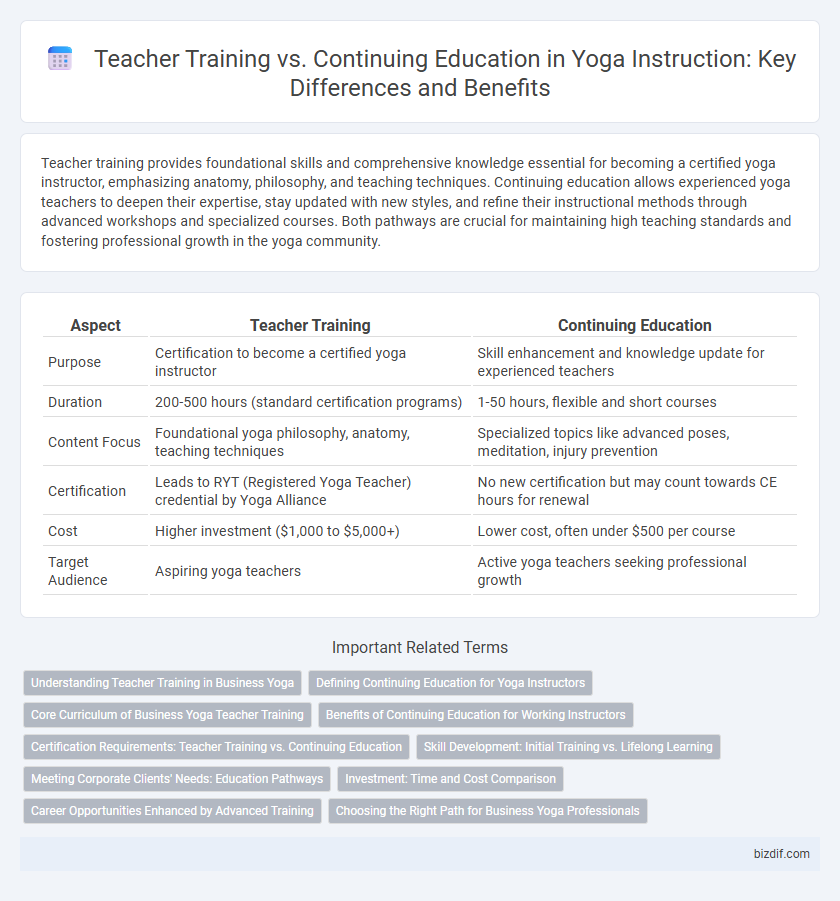Teacher training provides foundational skills and comprehensive knowledge essential for becoming a certified yoga instructor, emphasizing anatomy, philosophy, and teaching techniques. Continuing education allows experienced yoga teachers to deepen their expertise, stay updated with new styles, and refine their instructional methods through advanced workshops and specialized courses. Both pathways are crucial for maintaining high teaching standards and fostering professional growth in the yoga community.
Table of Comparison
| Aspect | Teacher Training | Continuing Education |
|---|---|---|
| Purpose | Certification to become a certified yoga instructor | Skill enhancement and knowledge update for experienced teachers |
| Duration | 200-500 hours (standard certification programs) | 1-50 hours, flexible and short courses |
| Content Focus | Foundational yoga philosophy, anatomy, teaching techniques | Specialized topics like advanced poses, meditation, injury prevention |
| Certification | Leads to RYT (Registered Yoga Teacher) credential by Yoga Alliance | No new certification but may count towards CE hours for renewal |
| Cost | Higher investment ($1,000 to $5,000+) | Lower cost, often under $500 per course |
| Target Audience | Aspiring yoga teachers | Active yoga teachers seeking professional growth |
Understanding Teacher Training in Business Yoga
Teacher training in business yoga provides comprehensive skills for aspiring instructors, covering anatomy, pedagogy, and class sequencing to ensure a solid foundation. Continuing education focuses on enhancing existing skills through workshops and specialized courses, promoting professional growth and updated teaching methods. Investing in teacher training equips educators with certification and credibility needed to establish a successful yoga instruction business.
Defining Continuing Education for Yoga Instructors
Continuing education for yoga instructors involves advanced training and workshops designed to deepen their practice, enhance teaching skills, and stay updated with the latest methodologies beyond initial teacher training. This education often includes modules on anatomy, specialized yoga styles, therapeutic techniques, and business development to support professional growth. Maintaining continuing education ensures adherence to accreditation standards and improves the quality of instruction delivered to students.
Core Curriculum of Business Yoga Teacher Training
Business Yoga Teacher Training emphasizes a comprehensive core curriculum that covers essential skills such as client management, marketing strategies, class sequencing, and ethical guidelines. Teacher training programs offer a structured and immersive learning experience designed for individuals seeking certification and foundational expertise in yoga instruction. Continuing education focuses on advanced topics and skill refinement, enabling certified instructors to deepen their knowledge and stay current with industry trends.
Benefits of Continuing Education for Working Instructors
Continuing education offers working yoga instructors updated methodologies, advanced techniques, and new styles that enhance class quality and student engagement. It supports professional growth by deepening anatomical knowledge and teaching skills, leading to improved student outcomes and instructor confidence. Access to workshops, certifications, and peer networks through ongoing training fosters adaptability in a dynamic wellness industry.
Certification Requirements: Teacher Training vs. Continuing Education
Yoga teacher training requires completion of a comprehensive curriculum often aligned with Yoga Alliance standards, culminating in certification that authorizes teaching professionally. Continuing education emphasizes ongoing skill enhancement through workshops, specialized courses, and short-term trainings, supporting credential renewal but not initial certification. Certification requirements for teacher training include extensive contact hours, anatomy studies, and teaching practicums, whereas continuing education mandates fewer hours focusing on advanced techniques and professional development.
Skill Development: Initial Training vs. Lifelong Learning
Teacher training in yoga provides foundational skill development, emphasizing anatomy, alignment, and teaching methodology essential for new instructors. Continuing education focuses on lifelong learning through advanced workshops, specialized techniques, and updated pedagogical strategies to refine and expand a teacher's expertise. Both stages are crucial for mastering skills and adapting to evolving practices within the yoga community.
Meeting Corporate Clients' Needs: Education Pathways
Teacher training provides a comprehensive foundation in yoga philosophy, anatomy, and teaching techniques essential for addressing diverse corporate wellness goals. Continuing education offers specialized workshops and certifications tailored to evolving corporate client demands, such as stress management, mindfulness, and ergonomics. Both education pathways equip yoga instructors with the skills to design adaptable programs that enhance employee well-being and productivity in corporate settings.
Investment: Time and Cost Comparison
Teacher training programs require a significant investment of time, often spanning several months to a year, with costs ranging from $2,000 to $5,000 depending on the school and location. Continuing education courses typically demand less time, usually a few hours to a few days, with expenses varying between $100 and $500, making them more accessible for maintaining certifications. Evaluating both options highlights that teacher training is a larger upfront commitment, while continuing education offers manageable, ongoing investments for skill enhancement.
Career Opportunities Enhanced by Advanced Training
Teacher training programs provide foundational skills and certification essential for launching a yoga teaching career, enabling access to entry-level positions in studios and wellness centers. Continuing education courses deepen expertise in specialized styles, anatomy, and therapeutic approaches, significantly expanding career opportunities in niche markets and advanced teaching roles. Advanced training certifications often lead to higher earning potential, invitations to lead workshops, and greater job stability within the competitive yoga industry.
Choosing the Right Path for Business Yoga Professionals
Teacher training provides foundational skills and certification necessary for launching a successful yoga teaching career, emphasizing anatomy, philosophy, and hands-on practice. Continuing education offers experienced yoga professionals advanced techniques, specialized styles, and business strategies to refine teaching skills and expand client reach. Selecting the right path depends on career stage, professional goals, and the need for credentials or skill enhancement to grow a sustainable yoga business.
Teacher training vs Continuing education Infographic

 bizdif.com
bizdif.com